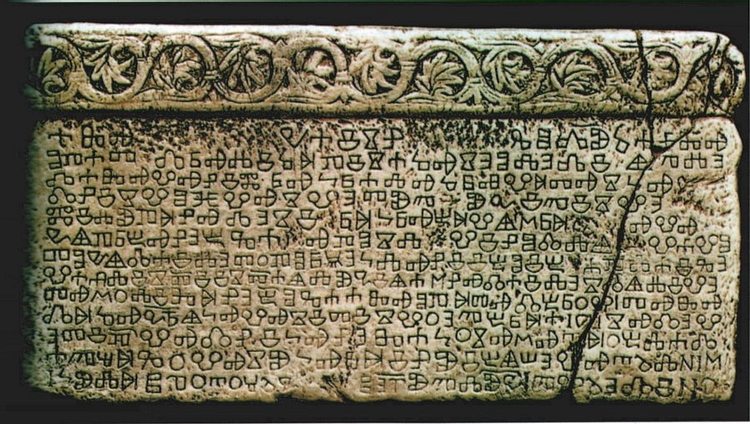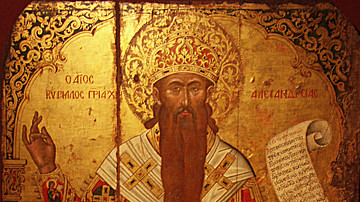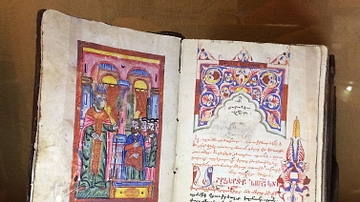
Saint Cyril (aka Kyrillos and Constantine the Philosopher, d. 867 CE) was a Byzantine linguist, teacher, scholar and missionary who famously preached Christianity to the Slavs in Moravia with his brother Methodius during the 9th century CE. He created the Glagolitic alphabet, the forerunner to the Cyrillic alphabet that bears his name, and did much to spread the religion, art and culture of the Byzantine empire into central Europe.
Early Life
Cyril is the monastic name the saint chose near the end of his life but he was born Constantine, the son of a military officer called Leo stationed in Thessaloniki; his mother may have been a Slav. He was a gifted linguist from an early age and was sent to Constantinople to further his education and study such languages as Syriac and Hebrew. Looked after by the eunuch Theoktistos, Cyril was ordained as a priest and served as an official at the Hagia Sophia church where he developed a close relationship with the Patriarch of Constantinople, the bishop Photios. The brilliant scholar quickly became the bishop's librarian. Cyril became a teacher of philosophy at the Magnaura university in Constantinople where he gained the epithet “Constantine the Philosopher”.
Cyril was next sent on two diplomatic missions, the first to the Muslim court at Samarra and the second to the Khazars, a Turkic tribe in the Caucasus, c. 860 CE. According to Cyril's 9th century CE biography, attributed to one of his disciples, the scholar monk was enthusiastic for the opportunity to spread the Gospel:
If you command, lord, on such a mission I shall gladly go on foot and unshod, lacking all the Lord forbade Hi disciples to bring.' The emperor answered, saying,: 'Well spoken, were you to do this [on your own]! But bear in mind the imperial power and honour, and go honourably and with imperial help.
Life of Constantine (in Shepard, 315)
The trip, unfortunately, ended in failure if it had intended to convert the Khazars to Christianity as the Byzantines only managed to baptise around 200 of them. The Khazaria state eventually adopted Judaism instead. Cyril did bring back souvenirs, though, said to be the relics of the exiled 1st century CE Bishop of Rome, Saint Clement. His ambitions were not dampened either as he promptly set off of his own accord into the Crimea to spread his message to the heathen Phoullai people. It is likely Cyril was not any more popular there, though, especially when he chopped down their sacred oak tree.
Mission to Moravia
Cyril was then selected by the Byzantine emperor Michael III (r. 842-867 CE) for a mission to Moravia (the modern Czech Republic and Slovakia) to spread the Christian faith. No doubt his ability to speak Slavic was a point in his favour and it would certainly come in useful. Prince Rastislav (r. 846-870 CE), eager to establish his own independent church using the Slavic language and ward off the encroaching Frankish Empire, had requested such a mission and Michael, happy to oblige, sent Cyril and his older brother Methodius in 863 CE, although neither held ecclesiastical office at the time. Michael was probably encouraged by Photios, the bishop of Constantinople, eager to keep pace with his great religious rival the Pope in Rome, who had himself just sent Frankish missionaries to the region. Indeed, although Cyril and Methodius have gained the reputation as the “Apostles to the Slavs”, they were by no means the first Christian missionaries to that people.
Cyril, to facilitate his preaching to the Slavs, invented, with some help from Methodius, the Glagolitic script which used some letters from Hebrew and Greek cursive writing to accurately capture the unique sounds of the Slavic language. The brothers had created the script before they even left home (the Slavic language having no written form previously) and used it to make translations of the liturgy of John Chrysostomos (Bishop of Constantinople from 398 to 404 CE), the Psalms of the Old Testament and the Gospels of the New Testament.
How is it that you now teach and have created letters for the Slavs, which none have found before?
Methodius asks Cyril, Life of Constantine (in Herrin, 131)
Although he succeeded in setting up many new churches, unfortunately for Cyril, Frankish bishops in Moravia who were pushing the case for the rival western half of the Christian church opposed his missionary work at every step. Conservative church clergy were also against the holding of services (or even disseminating religious literature) in any language outside the traditional trio of Latin, Greek, and Hebrew. The Frankish monks were steaming ahead with their Latin services to Slav congregations who understood not a word of the proceedings. Cyril and Methodius, meanwhile, were conducting theirs in Slavic, and in order to receive the blessing of Pope Adrian II, they held the mass in Latin first and then in Slavic.
As Cyril himself remarks on the importance of using local languages to communicate God's message:
We know of numerous peoples who possess writing, and render glory unto God, each in his own tongue. Surely these are obvious: Armenians, Persians, Abkhasians, Iberians, Sogdians, Goths, Avars, Turks, Khazars, Arabs, Egyptians and many others…Falls not God's rain upon all equally? And shines not the sun also upon all?
Life of Constantine (in Herrin, 133)

Death & Legacy
Cyril died in Rome in 867 CE on a mission to enlist the Pope's backing for his work in central Europe and to have some of his Slav disciples ordained. The traveller first presented the new pope, Hadrian II, with the relics of Saint Clement. The Moravians were then ordained and Slavonic scriptures donated to the church of St Maria and Praesepe. Cyril was buried in the shrine of San Clemente in the city.
The late missionary' s work was continued in Moravia by Methodius who went on to invent the Cyrillic alphabet (although it may have been created by his disciple Clement of Ohrid). This new writing, named in honour of Cyril, was derived from the Greek alphabet and was simpler than the rather intricate Glagolitic. A biography of Cyril was written shortly after his death, probably by his follower and fellow evangelist to the Slavs, Clement of Ohrid. The Cyrillic alphabet would itself inspire the script used in Russian, Bulgarian, Serbian and Macedonian.
Ultimately, the Moravians, pressured by the Franks, rejected the Byzantine church in favour of the western church. The favourable Rastislav had been succeeded by a less sympathetic ruler and Methodius and his followers were expelled from Moravia in 885 CE. Still, the experience gained by the missionaries and their library of translated texts were put to good use in their next port of call -Bulgaria, where Slavic was also spoken. Michael III pressed the case of Byzantine political and religious dominance there by assembling a menacing army on Bulgaria's border. The Bulgar ruler Boris was thus persuaded to favour the Byzantines and he travelled to Constantinople in 864 CE to be baptised in the Hagia Sophia by the emperor himself.






